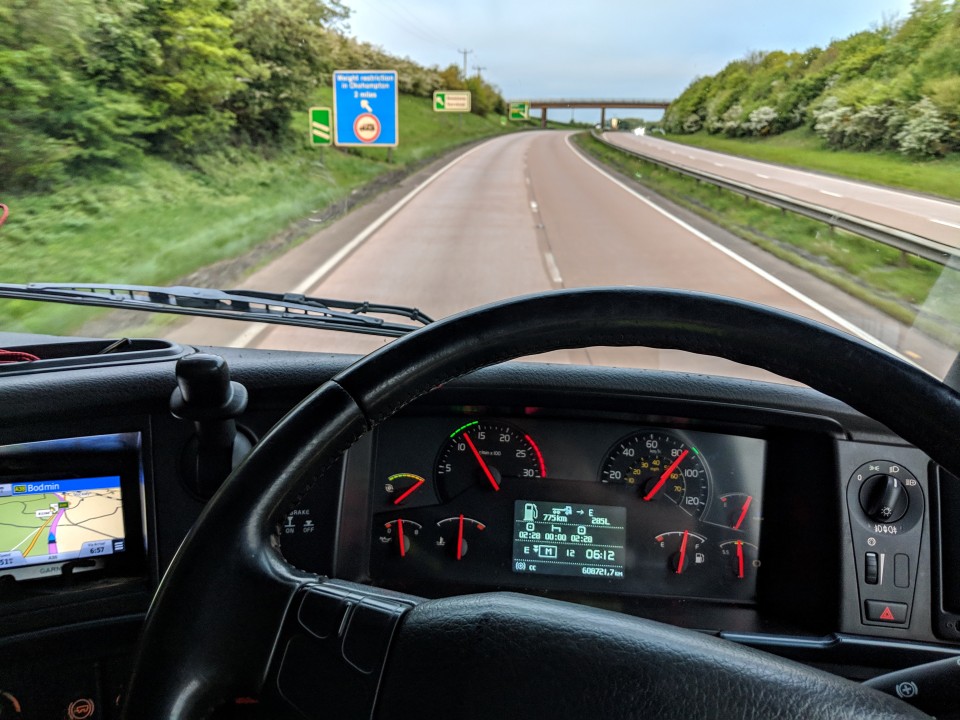
Susie Jones
How to be a healthy truck driver
Created: 27/08/2024
•
Updated: 27/08/2024
As a demanding profession, truck driving frequently involves long hours, a sedentary lifestyle, and extended periods away from home which can often take its toll on the health of many drivers.
Unhealthy habits such as the consumption of fast food, lack of physical activity, and disruptive sleeping patterns can all lead to potential health complications in the future. But how do you stay fit as a truck driver? It is easier said than done but we've compiled a list of tips to help keep you at your peak whilst on the road.
Six top tips for staying healthy on the road
1.Hydration
A simple tip and a commodity that we often take for granted, however, most health issues occur from dehydration. Regular sips of water or squash throughout the day will expel metabolic waste and toxins from your system and keep you more energized and alert. Keeping a refillable water bottle with you will not only remind you to stay hydrated but is better for the environment as well.
2.Diet
The temptation of fast food after a long day is something that we can all relate to, however, just like keeping hydrated, your diet plays a significant role in your health as well as how you will end up feeling throughout the day.
It is recommended that truck drivers eat three to four times a day, either two meals and two snacks or two meals and one snack. Try to maintain a meal and snack plan that is high in omega-3, iron, and vitamin C, such as green leafy vegetables, fish, and fruits. Avoid frequently consuming food and drink like pasta, bread, sweet drinks, and stimulants such as coffee and energy drinks.
Check out our list of healthy snacks to keep in your cab:
• Granola bars
• Energy bars
• Popcorn
• Nuts
• Dried fruit
• Dark chocolate
In addition to purchasing healthy food whilst out on the road, it can sometimes be healthier and more cost-effective to meal prep. Frieghtech has a fantastic selection of recipes to help you maintain a healthy diet whilst on the job.
3.Sleep
Due to the job's nature, getting enough sleep can be difficult for a truck driver and can lead to devastating results for everyone on the road.
Simple tips and tricks such as the following could assist you with a decent night's kip:
• Create an environment in the cab that feels like home. Check out our post about how to make your lorry cab a home
• Keep your sleep area dark
• A hot shower: Use our maps page to find out which truck stops offer this facility
• Try out some Apps to assist you with sleeping
• Find the ideal spot to park with little noise and disruption. Our intruck app provides 5,000 HGV (Heavy Goods Vehicle) locations across Europe for you to choose from whilst our SNAP Access and Security team can provide bespoke security solutions enabling you to get a better night’s sleep knowing that you and your truck are safe.
4.Exercise
One of the hardest tips to follow whilst out on the road but an important one, nonetheless. Long hours of sitting throughout the day can lead to poor posture, back pain, and potential health complications. After a long day behind the wheel, it may be tempting to sit and relax, however, a quick 15 minutes of activity like walking or stretching can make you feel rejuvenated and less stressed.
HMD Trucking has some useful exercises tailored for truck drivers if you are looking to incorporate several types of physical exercise into your routine.
5.Vitamins
Being out on the road full-time can make it difficult to get all your necessary vitamins. Taking a multivitamin each day can boost your immune system and help you stay healthy.
6.Mental Health
We know that looking after your physical health on the road is important but how much time do truck drivers take to look after their mental health?

The mental health charity Mind released statistics revealing that 30% of self-reported work-related illnesses in the transport and logistics industry are due to anxiety, loneliness, stress, and depression. They also implied that this number could be higher as most people do not seek the help they require. In addition to this, 95% of people off sick will not give the real reason for their absence from work if it is regarding their mental health.
Following the above tips and tricks can have a knock-on, positive, effect on your mental health. Furthermore, it is important to have open and honest conversations with other truck drivers, supervisors, or dispatchers.
Can exercise make you a better driver?
Not only does a healthy lifestyle lead to better mental health but evidence suggests that it can also make you a better driver. A study showed that drivers who were asked to exercise daily reported greater ease in turning their heads were able to rotate their bodies further and were able to get into their cars more rapidly.
What is the hardest part of being a truck driver?
Long hours appear to be one of the hardest aspects of truck driving. Truckers are often faced with long miles to cover and antisocial hours. These long miles and antisocial hours can lead to an unhealthy lifestyle.

How unhealthy is being a truck driver?
Due to the lifestyle of many truck drivers, on average, they are statistically more likely to have health problems compared to people in other careers. Truckers are often faced with a few obstacles such as cramped working spaces, stressful situations, unusual sleeping patterns, and lack of nutritional food that all have an influence on their health.
Maintaining a healthy lifestyle as a truck driver requires a conscious effort but the benefits of doing so are well worth it overall. The above tips will enable you to take control of your health and improve your well-being. Keep an eye out for more tips and tricks from us at SNAP.



